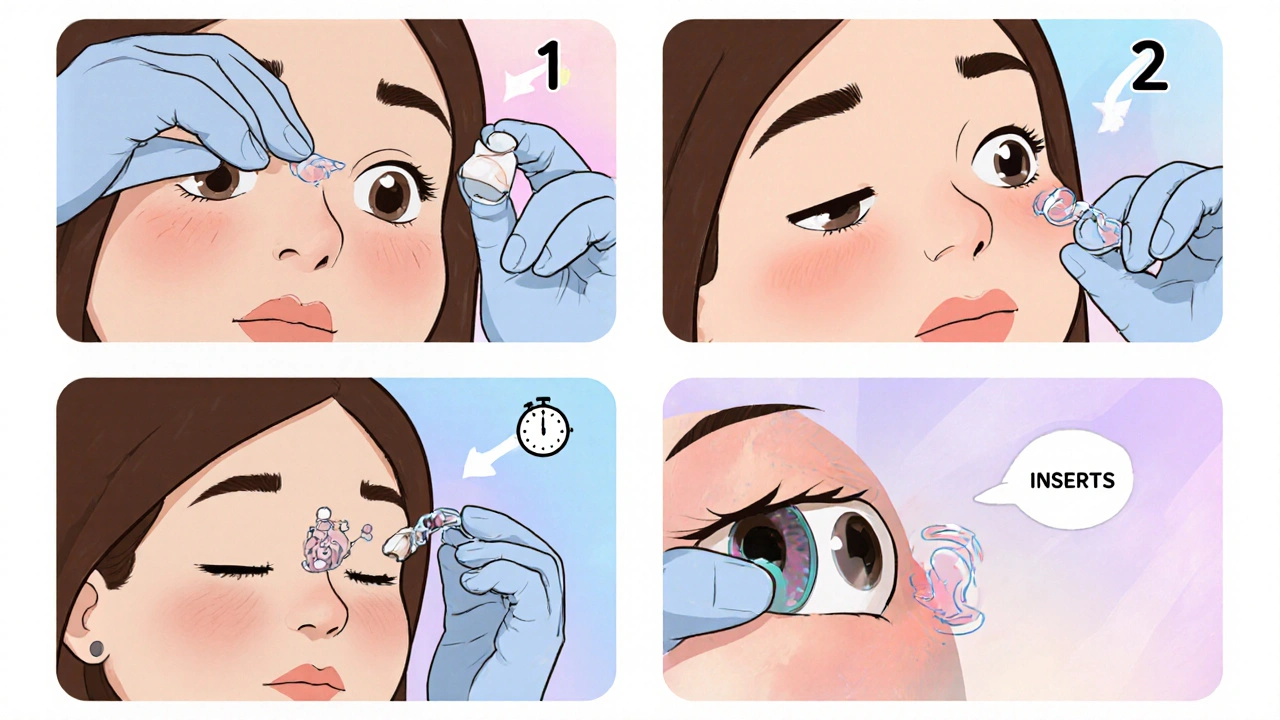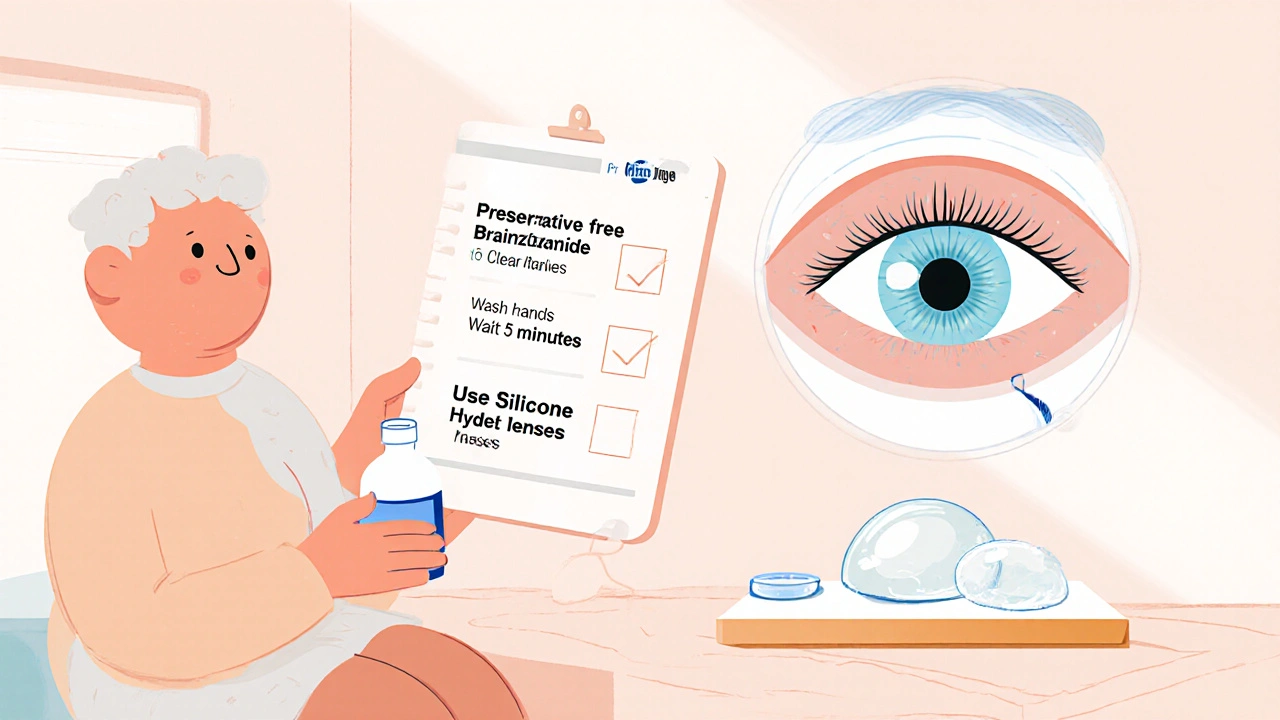Contact Lens Compatibility Checker
Check Your Compatibility
When you’re dealing with glaucoma, brinzolamide often becomes a daily habit. But what happens when you also wear contact lenses? Mixing eye drops with lenses isn’t as simple as it sounds-there are safety steps, timing tricks, and lens‑type choices that can keep your eyes comfortable and your vision clear.
What Is Brinzolamide?
Brinzolamide is a carbonic anhydrase inhibitor eye drop used to lower intraocular pressure in patients with glaucoma or ocular hypertension. It works by reducing the production of aqueous humor, the fluid that fills the front of the eye. The medication is typically prescribed as a 1% solution, applied twice daily.
Why Contact Lens Wearers Need Special Guidance
Contact lenses sit directly on the cornea, the same surface that receives any eye drop you place in the eye. If a drop’s formulation contains preservatives or has a high pH, it can stick to the lens, blur vision, or even damage the lens material. Moreover, lenses can trap medication, altering how much of the drug actually reaches the eye.
Most eye‑drop manufacturers, including the brand that sells brinzolamide, advise wearing lenses with caution. The goal is to avoid reduced drug efficacy and uncomfortable lens wear.
Key Precautions Before Applying Brinzolamide
- Check the label for preservative information. Brinzolamide is usually preserved with benzalkonium chloride (BAK), which can adhere to certain lens materials.
- Know your lens type. Silicone‑hydrogel lenses are more resistant to preservative build‑up than conventional hydrogel lenses.
- Plan your dosing schedule. Give the medication enough time to absorb before inserting lenses.

Choosing the Right Lens Material
Not every contact lens reacts the same way to brinzolamide. Below is a quick comparison of the most common lens categories.
| Lens Material | Preservative Tolerance | Typical Wear Schedule | Recommended for Brinzolamide Users? |
|---|---|---|---|
| Silicone‑hydrogel | High (less BAK adhesion) | Daily or extended wear | Yes, with proper timing |
| Soft hydrogel | Medium (some BAK buildup) | Daily replacement | Yes, but remove lenses after drop |
| Rigid gas permeable (RGP) | Low (minimal surface interaction) | Extended wear | Yes, but ensure lens cleaning |
| Hybrid lenses | Variable | Daily or bi‑weekly | Use with caution; consult eye‑care professional |
Step‑by‑Step Routine for Safe Use
Follow this simple timeline to keep both your medication effective and your lenses comfortable.
- Wash your hands. Use soap and water, dry with a lint‑free towel.
- Remove contact lenses. If you wear lenses daily, take them out before the drop.
- Apply brinzolamide. Tilt your head back, pull down the lower lid, and squeeze one drop onto the ocular surface. Close the eye gently for 1-2 minutes to let the drug absorb.
- Wait 5-10 minutes. This pause lets excess fluid drain and prevents the drop from pooling on the lens.
- Insert lenses (if you prefer wearing them after the drop). Use a fresh lens if your schedule permits; avoid re‑using a lens that just sat in the drop bottle.
- Re‑apply if you need a second daily dose. Follow the same steps, but give an extra 10‑minute gap before lens insertion.
For night‑time users who keep lenses in while sleeping, consider a preservative‑free formulation of brinzolamide if your doctor prescribes it. Preservative‑free drops reduce the risk of lens discoloration and surface damage.
Common Side Effects and When to Seek Help
- Blurred vision. Usually temporary; if it lasts more than 30 minutes, rinse the eye with sterile saline. \n
- Dryness or irritation. Use preservative‑free artificial tears between drops and lens wear.
- Lens discoloration. Switch to a silicone‑hydrogel lens or a preservative‑free drop.
- Increased intra‑ocular pressure despite treatment. Contact your eye doctor immediately; dosage adjustment might be needed.

Pro Tips From Eye‑Care Professionals
- Keep a dedicated bottle of brinzolamide for lens‑free use. This prevents accidental contamination of a preservative‑free bottle.
- Store your contact lenses in fresh solution every night. Old solution can react with residual BAK from the drops.
- Rotate lens brands every few months to give your cornea a break from any lingering chemicals.
- If you experience persistent redness, consider switching to a preservative‑free version of brinzolamide. Your pharmacist can advise on availability.
Answering the Most Frequently Asked Questions
Can I wear contact lenses immediately after using brinzolamide?
It’s safest to wait at least five minutes after the drop before inserting lenses. This gives the medication time to absorb and reduces the chance of the drug sticking to the lens surface.
Do preservative‑free brinzolamide drops exist?
Yes. Some pharmacies stock preservative‑free formulations, which are gentler on lenses and the ocular surface. Ask your pharmacist or eye‑care provider for details.
Which contact lens material is best with brinzolamide?
Silicone‑hydrogel lenses typically handle preservatives better than traditional hydrogel lenses. RGP lenses also work well, but comfort varies per individual.
What should I do if my lenses turn cloudy after using the drop?
Remove the lenses, rinse them with fresh sterile solution, and discard if the cloudiness persists. Switch to a preservative‑free drop or a different lens material.
Is it okay to use brinzolamide with other glaucoma drops?
Often, yes. Many patients combine brinzolamide with a beta‑blocker like timolol for better pressure control. However, coordinate timing to avoid wash‑out effects-usually one drop in the morning, the other in the evening.
Bottom Line: Stay Informed, Stay Safe
Mixing brinzolamide with contact lenses isn’t a deal‑breaker; it just needs a bit of planning. Choose a lens that tolerates preservatives, wait a few minutes after each dose, and keep a backup bottle of preservative‑free drops if you notice irritation. When in doubt, a quick call to your eye‑care professional can prevent a small inconvenience from turning into a bigger problem.


Rakhi Kasana
When you apply brinzolamide, the preservative BAK can cling to hydrogel lenses, creating a hazy film that interferes with vision.
Even though the drop is essential for intra‑ocular pressure control, the timing of insertion matters.
Removing lenses before the drop and waiting five to ten minutes allows absorption without compromising lens integrity.
For silicone‑hydrogel wearers, the risk is lower, but a brief waiting period is still advisable.
Think of it as a disciplined ritual rather than a chore.
Sarah Unrath
i wnt 5 minz before puttin lens
James Dean
The act of waiting is a small meditation between treatment and comfort.
It respects the pharmacokinetics of the carbonic anhydrase inhibitor while preserving the lens surface.
In practice a quiet five‑minute pause does not disrupt daily flow.
Leo Chan
Great reminder to give the drop a moment to settle.
Keeping your lenses fresh after each dose also helps avoid buildup.
Stay consistent with the schedule and your eyes will thank you.
Remember, a little patience goes a long way for clear vision.
Latasha Becker
From a pharmacodynamic perspective, brinzolamide’s efficacy hinges on its direct interaction with the corneal epithelium, wherein preservative components such as benzalkonium chloride may alter surface tension dynamics.
Consequently, the physicochemical compatibility between the aqueous formulation and the lens polymer matrix becomes a critical parameter in therapeutic planning.
Silicone‑hydrogel lenses, characterized by a higher oxygen permeability coefficient (Dk/t), exhibit reduced affinity for cationic surfactants, thereby mitigating BAK deposition.
Conversely, conventional hydrogel lenses possess a hydrophilic network that can entrap preservative molecules, leading to optical attenuation and potential cytotoxicity.
Empirical data from in‑vitro assays demonstrate a statistically significant increase in light‑scatter indices when hydrogel lenses are exposed to BAK‑containing drops without an interceding clearance interval.
Clinical guidelines therefore advocate a minimum latency of five minutes post‑administration before lens reinsertion to facilitate tear‑film turnover and drug diffusion.
In scenarios where patients prefer continuous wear, preservative‑free formulations of brinzolamide offer a viable alternative, effectively eliminating the preservative‑lens interaction pathway.
Moreover, the utilization of high‑frequency silicone‑hydrogel lenses can further attenuate adverse events owing to their surface‑treated coatings that repel protein and lipid adherence.
It is also prudent to maintain discrete dispensing bottles for lens‑free and lens‑on regimens, thereby precluding cross‑contamination risks that could compromise sterility.
Periodic lens replacement, ideally on a bi‑monthly schedule, mitigates cumulative preservative load, preserving both visual acuity and corneal health.
Patients should be counseled on the importance of hand hygiene, as inadvertent transfer of residual BAK to the lens case can exacerbate deposition phenomena.
Adjunctive therapy with preservative‑free artificial tears can restore tear‑film homeostasis between dosing intervals.
Should visual blur persist beyond thirty minutes, a saline rinse is advisable prior to lens reinsertion to evacuate residual medication.
In the event of chronic irritation or lens discoloration, a reassessment of the therapeutic regimen, including potential substitution with alternative carbonic anhydrase inhibitors, is warranted.
Ultimately, an individualized approach that aligns lens material selection, dosing schedule, and formulation type optimizes both intra‑ocular pressure control and ocular surface comfort.
parth gajjar
Ah the drama of a drop clinging to a lens – a tragic ballet of chemistry and vanity.
One misstep and the evening vision dissolves into a cloudy abyss.
Respect the timeout and the lenses shall remain your faithful companions.
Maridel Frey
To ensure optimal outcomes, it is advisable to document the exact timing of each drop relative to lens insertion.
This systematic approach facilitates communication with your eye‑care professional and supports longitudinal monitoring.
Consistent adherence to the recommended interval also reduces the likelihood of preservative‑induced complications.
Madhav Dasari
Keep the routine simple – drop, wait, then slip those lenses back on, and you’ll sail through the day.
Your eyes will thank you.